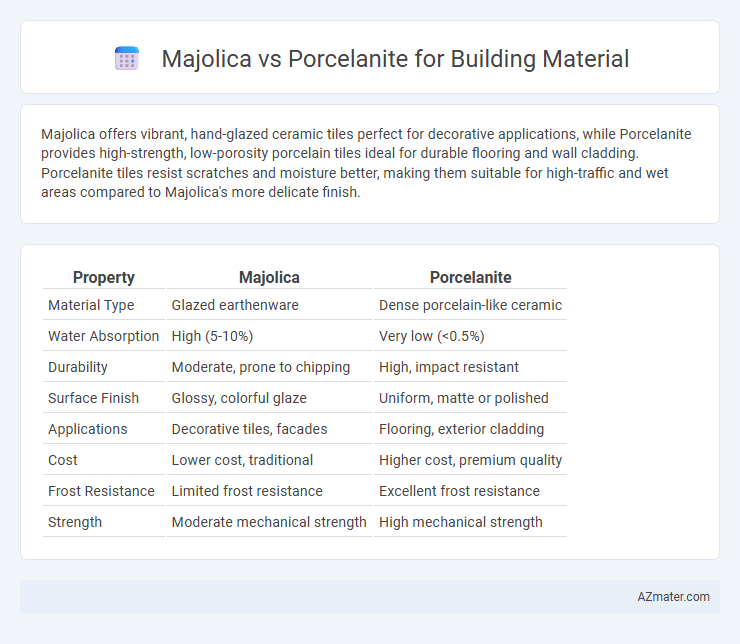Majolica offers vibrant, hand-glazed ceramic tiles perfect for decorative applications, while Porcelanite provides high-strength, low-porosity porcelain tiles ideal for durable flooring and wall cladding. Porcelanite tiles resist scratches and moisture better, making them suitable for high-traffic and wet areas compared to Majolica's more delicate finish.
Table of Comparison
| Property | Majolica | Porcelanite |
|---|---|---|
| Material Type | Glazed earthenware | Dense porcelain-like ceramic |
| Water Absorption | High (5-10%) | Very low (<0.5%) |
| Durability | Moderate, prone to chipping | High, impact resistant |
| Surface Finish | Glossy, colorful glaze | Uniform, matte or polished |
| Applications | Decorative tiles, facades | Flooring, exterior cladding |
| Cost | Lower cost, traditional | Higher cost, premium quality |
| Frost Resistance | Limited frost resistance | Excellent frost resistance |
| Strength | Moderate mechanical strength | High mechanical strength |
Introduction to Majolica and Porcelanite
Majolica is a traditional ceramic tile known for its vibrant colors and intricate patterns, often glazed to provide durability and water resistance, making it a popular choice for decorative architectural surfaces. Porcelanite, a high-density porcelain tile, offers superior strength, low porosity, and excellent resistance to wear and stains, ideal for both indoor and outdoor applications requiring long-lasting performance. Selecting between Majolica and Porcelanite depends on the balance between aesthetic appeal and functional requirements in building projects.
Material Composition and Manufacturing Process
Majolica tiles consist primarily of earthenware clay coated with a tin-based glaze that creates a porous, brightly colored surface. Porcelanite tiles are produced from highly refined clay mixed with feldspar, quartz, and kaolin, then fired at extremely high temperatures to achieve a dense, vitrified structure. The manufacturing process for Majolica involves hand-painting and a single firing, while Porcelanite undergoes pressing and double or triple firing to ensure durability and water resistance.
Aesthetic Qualities and Design Options
Majolica tiles offer vibrant colors and intricate hand-painted designs that provide rich aesthetic appeal and traditional charm, ideal for artistic and decorative applications. Porcelanite boasts a sleek, modern appearance with a wide range of textures, finishes, and large-format options, delivering versatility for contemporary architectural designs. Both materials enhance visual appeal through distinctive surface qualities, but Majolica emphasizes ornate patterns while Porcelanite prioritizes minimalist and durable elegance.
Durability and Strength Comparison
Majolica tiles offer moderate durability with a glazed surface that is prone to chipping and scratching under heavy impact, making them suitable for decorative applications rather than high-traffic areas. Porcelanite, a type of porcelain tile, exhibits superior strength and enhanced resistance to wear, moisture, and stains due to its dense vitrified composition, making it ideal for both interior and exterior use. The high durability of Porcelanite ensures longevity in demanding environments, outperforming Majolica in terms of mechanical strength and maintenance requirements.
Water and Stain Resistance
Majolica tiles are known for their vibrant designs but generally exhibit lower water and stain resistance due to their porous surface and glazed finish, making them less ideal for high-moisture areas. Porcelanite, a type of porcelain tile, offers superior water absorption rates below 0.5%, resulting in excellent resistance to water penetration and stains. This makes Porcelanite a more durable and low-maintenance option for environments prone to moisture and heavy staining.
Maintenance and Cleaning Requirements
Majolica tiles require regular sealing and gentle cleaning with non-abrasive products to prevent staining and surface damage, making maintenance moderately intensive. Porcelanite tiles are highly resistant to stains, scratches, and water absorption, allowing for easy cleaning with basic detergents and minimal upkeep. Choosing Porcelanite reduces long-term maintenance costs due to its durability and low porosity compared to the more porous Majolica.
Cost and Budget Considerations
Majolica tiles typically cost less than porcelanite tiles due to their traditional manufacturing process and materials, making them a budget-friendly option for decorative projects. Porcelanite, a type of porcelain tile, offers superior durability and water resistance but comes with a higher price tag that may impact overall construction budgets. Choosing between majolica and porcelanite requires balancing upfront costs with long-term value, especially in high-traffic or moisture-prone areas.
Installation Methods and Challenges
Majolica tiles require precise mortar application and careful alignment to prevent cracking due to their intricate glazed surfaces, while Porcelanite tiles demand enhanced surface preparation and often utilize thin-set adhesives or mechanical fasteners for secure installation. The porous nature of Majolica can pose challenges in moisture absorption during installation, necessitating sealing, whereas Porcelanite's dense, non-porous structure minimizes water absorption but requires specialized cutting tools to avoid chipping. Installation of Majolica suits artisanal craftsmanship settings, contrasting with Porcelanite's compatibility with large-scale projects demanding durability and uniformity.
Environmental Impact and Sustainability
Majolica tiles are often less sustainable due to their high energy consumption during firing and the use of natural clays, which can lead to resource depletion. Porcelanite, a type of porcelain tile, offers better environmental performance with lower water absorption, longer durability, and often incorporates recycled materials, reducing waste. Porcelanite's manufacturing processes typically prioritize energy efficiency and minimize emissions, making it a more eco-friendly choice for sustainable building projects.
Best Applications: Majolica vs Porcelanite in Construction
Majolica tiles excel in decorative applications due to their vibrant colors and intricate patterns, making them ideal for wall cladding, backsplashes, and accent features in residential and commercial projects. Porcelanite, a type of porcelain tile known for its high durability, low porosity, and resistance to heavy traffic, suits flooring in high-traffic areas, outdoor facades, and wet environments like bathrooms and kitchens. Selecting Majolica for aesthetic appeal and Porcelanite for structural strength ensures optimal performance and longevity in diverse construction settings.

Infographic: Majolica vs Porcelanite for Building material
 azmater.com
azmater.com